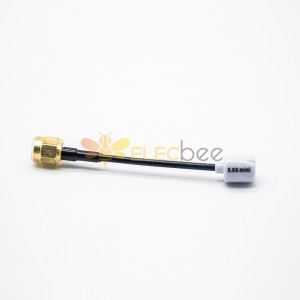Whether you're diving into the adrenaline-pumping world of drone racing or capturing awe-inspiring aerial shots in freestyle flying, the quality of your FPV (First Person View) experience is crucial. Today, we dive deep into the intricacies of the 5.8G RP-SMA FPV High Gain Lollipop Antenna—a product that promises a balance of performance and versatility for drone enthusiasts.
What is an FPV Antenna?
An FPV antenna isn't just a piece of metal; it's a sophisticated device responsible for transmitting and receiving electromagnetic waves. This plays a significant role in the stability of signals and minimizes signal loss, which is invaluable in applications ranging from competitive drone racing to leisurely weekend flying.

Key Features
Versatile Frequency Range
This antenna distinguishes itself with a broad frequency range of 5500-5950 MHz. Not only does this range make it versatile for different flying environments, but it also ensures that the antenna is compatible with most 5.8G systems out there. This effectively future-proofs your purchase as technology evolves.
Polarization Types
The antenna's Right-Hand Circular Polarization (RHCP) contributes to reducing multipath interference, which occurs when signals bounce off obstacles. This ensures that you get a cleaner, more reliable signal, essential for critical moments in drone races or during complicated freestyle maneuvers.
Modest Gain
While a gain of 2 dBi may seem modest, it provides a surprisingly effective balance for various applications. The gain factor directly impacts the antenna's ability to focus radio frequency energy. In practical terms, this antenna strikes a good balance, offering consistent performance without overpowering certain directions, which is a common issue with higher-gain antennas.
Technical Specifications
Input Impedance
With a standard input impedance of 50Ω, this antenna avoids impedance mismatches, a factor that can lead to signal reflection and poorer performance.
VSWR
A VSWR (Voltage Standing Wave Ratio) of ≤1.3 at 5800 MHz means that this antenna maintains a highly efficient transfer of energy from the transmitter to the antenna itself. In layman's terms, less energy is reflected back into the system, leading to better performance and reduced risk of equipment damage.
Maximum Input Power
Able to handle up to 50 watts of input power, this antenna provides a substantial safety margin during those intense moments when you might push your drone to its limits.
Connector Types
Perhaps one of the most versatile aspects of this antenna is its wide array of supported connectors: RP-SMA, SMA, angle MMCX, straight MMCX, and UFL. This compatibility makes it incredibly adaptable, fitting multiple drone setups without requiring you to purchase different antennas.

Pros and Cons
Pros
- Broad Frequency Range: Adaptable to various environments and technologies.
- High-Quality Material: Crafted from durable ABS material that withstands wear and tear.
- Connector Versatility: Supports multiple connector types, simplifying drone setup.
- Weather Resilience: Designed to operate in a wide temperature range from -40 to 60°C, making it suitable for a variety of climates.
Cons
- Limited User Reviews: While the technical specifications are promising, the antenna could benefit from more user testimonials for a well-rounded perspective.
Real User Reviews
- "This antenna has revolutionized my drone racing setup. The signal reliability is a game-changer for competitive racing." - Elecbee Reviewer
- "Its robust build quality and effective impedance matching have resulted in remarkably stable signals during my freestyle flights. Highly recommended!" - Drone Enthusiast Blog
- "The connector versatility is a huge plus. It saved me from having to buy different antennas for my multiple drone setups." - Forum User
Conclusion and Recommendations
The 5.8G RP-SMA FPV High Gain Lollipop Antenna shines in several key areas, from its wide frequency range and polarization options to its connector versatility. If you're looking for an FPV antenna that promises robust performance without compromising on adaptability, this is a product worth considering.
Check out the 5.8G RP-SMA FPV High Gain Lollipop Antenna on Elecbee

Note: This review incorporates technical specifications from Elecbee and other platforms to offer a balanced perspective.
Fly safely and make the most of your aerial adventures!







